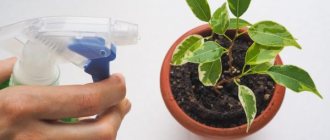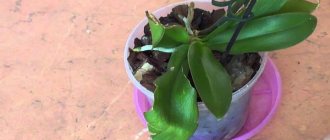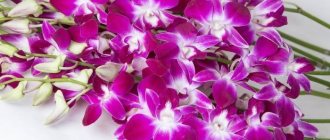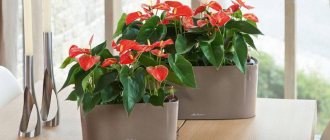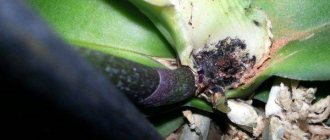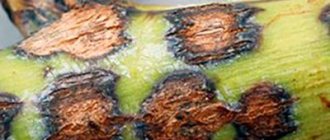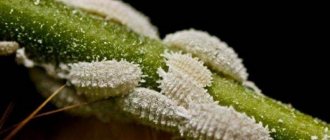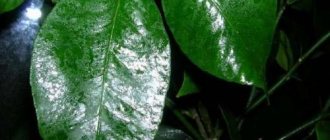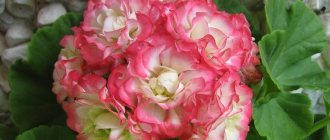Features of flower growth
Geranium can be called an unpretentious flower ; it loves a lot of sun, warmth and soil that allows air and water to pass through. The content conditions are as follows:
- good watering in summer and moderate in winter;
- bright sunlight, but without direct rays;
- warm air;
- loose, well-drained soil;
- moderate fertilizing with nitrogen-phosphorus-potassium fertilizers;
- slightly acidic soil;
- pruning and pinching to form a bush.
Diagnosis of the problem
Small light spots appeared
Clear yellow spots with smooth edges on the front side of the sheet, and on the inside a brown coating is rust, which often appears if the air is warm with high humidity.- A small fluff on the leaves, light spots, while the plant becomes lethargic and unattractive with dark formations on the leaves - this is Botrytis, a parasitic fungus. The disease appears from excess humidity.
- A ring pattern on pale green spots that gradually merge, while the plant stops growing and developing, flower stalks do not form - this is ring spotting. The cause of this disease is nematodes living in the soil.
- Another serious infection is the appearance of spider mites. Yellow spots appear on the leaves, they gradually begin to fall off, while the plant seems to be entangled in a small, barely noticeable web.
Brown drawings
- Brown spots appeared on the lower leaves - this is gray rot; if the plant is not treated, then over time the spots become covered with a gray coating, which tightly covers first the geranium leaves, then the stem.
- If a light spot appears in the middle of the brown spots, then this is Alternaria blight. The disease manifests itself as follows: the leaves turn yellow and dry out, while the plant stops gaining color. If the air humidity is high, then all parts of the geranium become covered with a velvety coating.
- Red-brown spots indicate that the plant is in direct sunlight, while the air temperature is much lower than optimal (why do geranium leaves turn red?).
Medicinal preparations for geranium
The following medications can be used to combat geranium problems:
- Aspirin. It can be used when insects are detected. To prepare the solution you will need one tablet of medicine and 8 liters of water. The resulting composition must be sprayed on geranium leaves. The procedure can be repeated after 3 weeks.
- Marathon. This drug is also intended to combat insects, but they need to be watered in the soil. The procedure can be carried out a few days after planting.
- Messenger.Used to increase the plant’s own immunity.
- Monterey. It is sprayed onto plants when traces of caterpillars are found on it.
Geranium has long been considered one of the most useful plants. The medicinal flower is capable of killing a huge number of bacteria and treating a variety of diseases, from a common runny nose to purulent wounds. That is why high-quality care will allow its owner to create a healing atmosphere in his home.
Useful!5Not very useful!3
Publications on the topic:
- Kalanchoe in a pot: replanting, home care
- What to do when Kalanchoe does not bloom at home?
- Are the leaves of indoor geraniums turning yellow? Find out why this happens and what to do about it!
Causes of leaf blade disease
In most cases, improper care of geraniums leads to changes in leaf color.
For example, yellow formations may appear on leaves if errors are made in care:
- lack of moisture - the leaves begin to turn yellow at the edges;
- excessive watering - against the background of lethargy of the geranium, yellowness appeared;
- poor lighting - leaves can not only turn yellow, but also fall off.
Brown spots on the leaves of a flower can appear not only from diseases, for example:
the flower grew, and the flowerpot became too small for it;- the soil in the hill is poorly drained;
- constant drafts;
- lack of light and heat;
- excess nitrogenous fertilizers;
- planting outdoors without pre-cultivation of the soil.
In addition, there are insects such as:
- whitefly;
- aphid;
- mealybug.
They cause various spots to appear on the leaves.
You can learn more about common geranium leaf diseases here.
How to get rid of the problem - detailed instructions
First of all, the flower is quarantined so that it does not infect other crops in the apartment. A careful examination of the roots, soil, leaves, and stems will help you make the correct diagnosis.
Rust
If your geranium is affected by rust, then you should take the following measures::
- move the flowerpot with the plant to a dry and cool place;
- reduce watering to a minimum;
- diseased leaves should be cut off;
- treat geranium with Topaz - a special preparation.
It is worth understanding that a flower can be cured only at the initial stage of infection.
Fungus
If geranium is infected with Botrytis fungus, you will have to act as follows:
- cut off all affected areas;
- treat with systemic fungicides;
- reduce watering;
- loosen the soil.
Ring spot
If a flower is affected by this disease, it cannot be cured.
As soon as you notice the first symptoms of ring spot, destroy the plant and the soil in which it was located.
Spider mite
To get rid of spider mites, you need to put in a lot of effort. It is worth noting that this parasite is a microscopic animal, so it is useless to use insecticides . The algorithm of actions is as follows:
- Give the plant a warm shower with laundry soap - this process destroys 50% of the entire parasite population.
- Wash everything that was near the plant, disinfect the windowsill and window, wash the curtains.
- Water the plant and pack it in a plastic bag for 3 days. The tick does not tolerate high humidity.
All these actions will help only at the initial stage of the disease; if the web has entangled the entire plant, it will have to be destroyed.
Alternaria blight
Often a plant becomes infected with this disease through the soil ; it can be cured as follows:
- change the soil in the flowerpot;
- treat geranium with Ridomil Gold or Skor;
- ventilate the room daily;
- loosen the soil;
- use the optimal humidification regime.
Insects can be removed in the following ways:
- Wash the flower with soapy water.
- Wipe with a cotton swab soaked in an alcohol solution.
- Treat with medications.
We grew up. What's next?
Pelargoniums are wonderful companions both at home and in the garden, as they are powerful natural repellents and successfully drive away flies, as our great-grandmothers knew very well.
With the arrival of stable warmth, pelargoniums can be planted in open ground - there the plants will unfold in all their glory. Mature home geraniums do not need to be disturbed by replanting, but can be cut from them as many cuttings as you like, each of which will develop into a large branched bush during the gardening season. In the fall, the most successful plants can be returned to the apartment, or cuttings can be taken from them and rooted in the apartment.
This “geranium conveyor belt” can be endless, which cannot be said about propagation by one’s own seeds. If you have several varieties, they will certainly be cross-pollinated, and the seeds resulting from such crossing will be unpredictable in terms of maintaining varietal characteristics.
Pure varieties of pelargonium with the declared characteristics of color, size, and degree of flower terry can only be obtained from the seeds of the originator. These are always in our catalog.
By the way, be sure to tell us in the comments about your pelargoniums and how to propagate them. And take a few minutes for a short master class from our pelargonium specialist - there is a lot of useful information and an overview of the most popular varieties
Preventive measures
Geranium is resistant to infections, but preventative measures will help avoid problems. Observe the behavior and condition of the plant , and it is worth maintaining:
- optimal soil moisture;
- temperature regime comfortable for the plant;
- good lighting;
- correct and timely feeding.
Typical mistakes in caring for geraniums lead to loss of pigment or leaf disease. Read our articles about why a flower’s leaf blade curls or turns white and how to solve the problem.
Despite the fact that geranium is an unpretentious plant, it needs to be looked after and constantly taken care of. If you are vigilant, you can easily avoid illness or treat the infection at an early stage.
How to feed and fertilize geraniums correctly
This crop rarely needs replanting and can grow in one pot for more than one year. Fertilizing is done with liquid universal fertilizer for flowering crops once every 2-3 weeks. The solution must be prepared according to the instructions on the package.
Geranium feeding technology:
- mineral fertilizers (potassium and phosphorus) are added 2 times a month. These microelements prolong flowering and strengthen the crop;
- watering with a heteroauxin solution or sweet water will help geraniums bloom in winter. An artificial or natural stimulant must be added weekly;
- ready-made complex fertilizer. Added according to instructions.
Note! Pelargonium “loves” natural fertilizer in the form of ordinary iodine in a proportion of 1 ml per 1 liter of warm water
Feeding geraniums with iodine
The iodine solution is added as follows:
- the soil is watered;
- when the soil dries out a little, add iodine fertilizer (pour along the wall of the pot at a distance of at least half a centimeter from the plant).
There are some recommendations for feeding geraniums that will ensure the plant looks healthy and blooms profusely.
The feeding rules are as follows:
- If the crop has been exposed to improper lighting for a long time, it is not recommended to feed it. First you need to fix this error;
- if a plant is “diagnosed” with a disease or pests are found on it, then first you need to get rid of them, and only then feed them;
- after adding fertilizers, it is worth loosening the soil in the pot to ensure oxygen access to the roots;
- You cannot fertilize the crop more than once a week;
- for young flowers and in winter, the dose of bait should be halved.
Geranium is a universal beautiful flower that, with proper care, will delight you with lush inflorescences and a pleasant aroma. Now, knowing how to care for (geranium blooms better with proper care) this beautiful plant, there should be no problems with its cultivation.
